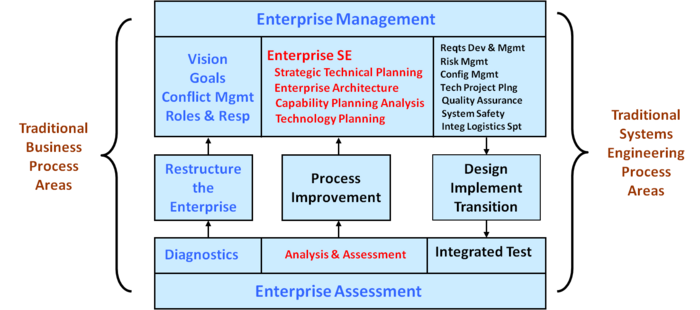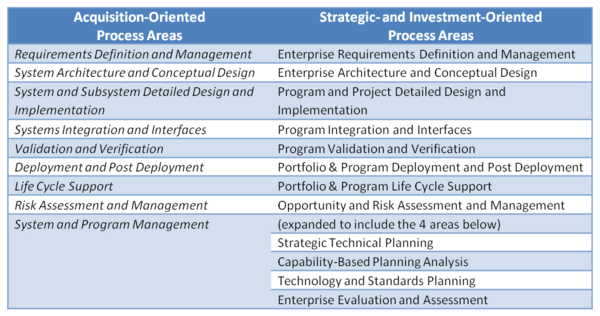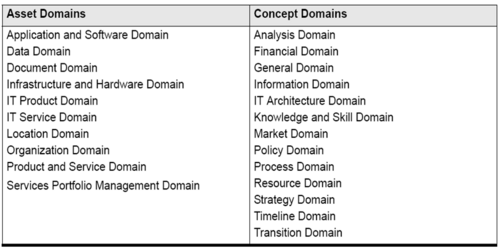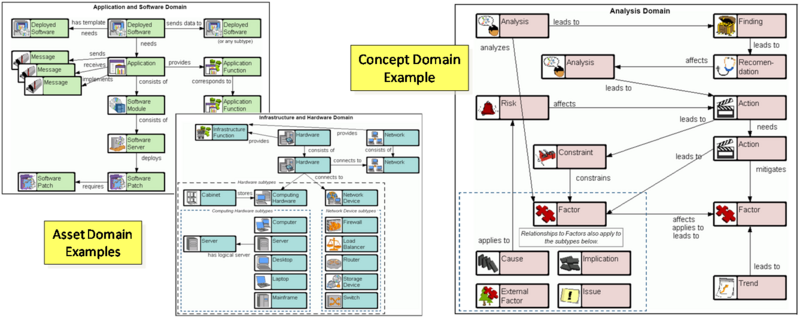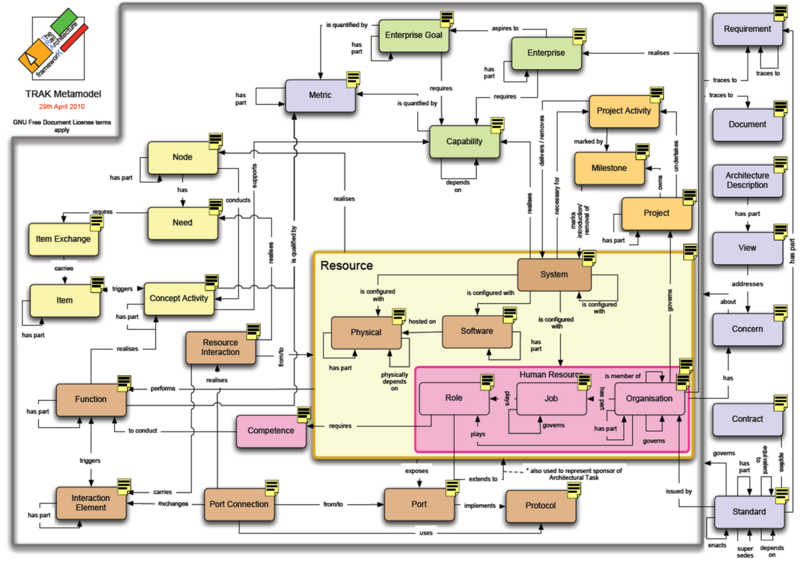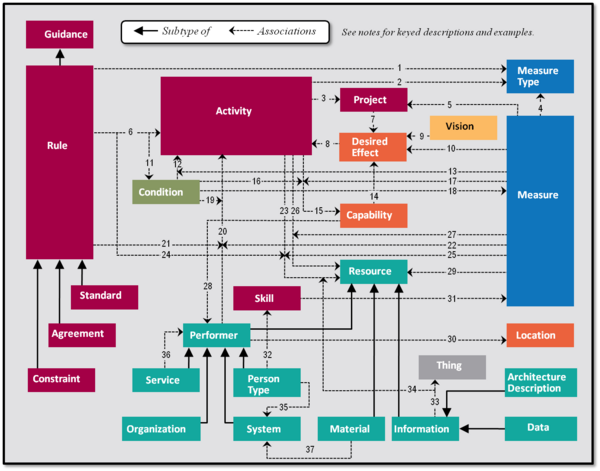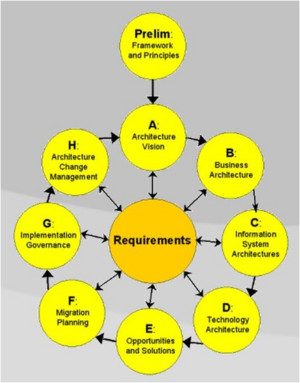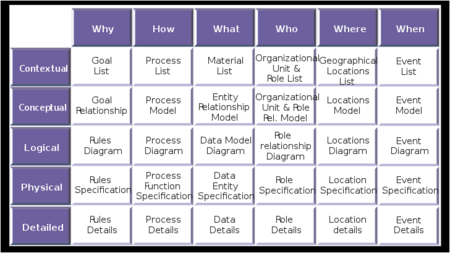Difference between revisions of "Enterprise Systems Engineering Key Concepts"
| Line 104: | Line 104: | ||
6.5.1 | 6.5.1 | ||
| − | ==References== | + | ==References== |
| − | + | Please make sure all references are listed alphabetically and are formatted according to the Chicago Manual of Style (15th ed). See the [http://www.bkcase.org/fileadmin/bkcase/files/Wiki_Files__for_linking_/BKCASE_Reference_Guidance.pdf BKCASE Reference Guidance] for additional information. | |
| + | ===Citations=== | ||
| + | List all references cited in the article. Note: SEBoK 0.5 uses Chicago Manual of Style (15th ed). See the [http://www.bkcase.org/fileadmin/bkcase/files/Wiki_Files__for_linking_/BKCASE_Reference_Guidance.pdf BKCASE Reference Guidance] for additional information. | ||
| + | ===Primary References=== | ||
| + | All primary references should be listed in alphabetical order. Remember to identify primary references by creating an internal link using the ‘’’reference title only’’’ ([[title]]). Please do not include version numbers in the links. | ||
| + | ===Additional References=== | ||
| + | All additional references should be listed in alphabetical order. | ||
====Article Discussion==== | ====Article Discussion==== | ||
Revision as of 17:26, 24 June 2011
6.5 ESE Key Concepts (3.1.4)
The purpose of TSE is to bring together a diversity of discipline experts to address a wide range of problems inherent in the development of a large, complex “single” system. (Blanchard 2010; Hall 1989; Sage and Rouse 2009) ESE expands beyond this traditional basis to “consider the full range of SE services increasingly needed in a modern organization where information-intensive systems are becoming central elements of the organization’s business strategy.” (Carlock and Fenton 2001, 242-261) The traditional role of SE is heavily involved in system acquisition and implementation, especially in the context of government acquisition of very large, complex military and civil systems (e.g., F22 fighter jet and air traffic control system).
ESE encompasses this traditional role in system acquisition, but also incorporates enterprise strategic planning and enterprise investment analysis. These two additional roles for SE at the enterprise level are “shared with the organization’s senior line management, and tend to be more entrepreneurial, business-driven, and economic in nature in comparison to the more technical nature of classical systems engineering.” (Carlock and Fenton 2001, 242-261)
6.5.1
Closing the Gap
The MITRE Corporation has done significant development of ESE practices.
Today the watchword is enterprise systems engineering, reflecting a growing recognition that an “enterprise” may comprise many organizations from different parts of government, from the private and public sectors, and, in some cases, from other nations. (MITRE 2004)
(Rebovich 2006) says there are “new and emerging modes of thought that are increasingly being recognized as essential to successful systems engineering in enterprises.” In addition to the TSE process areas, MITRE has included the following process areas in their ESE process (DeRosa 2005) to close the gap between ESE and product SE:
- Strategic Technical Planning
- Enterprise Architecture
- Capabilities-Based Planning Analysis
- Technology Planning
- Enterprise Analysis and Assessment
These ESE processes are shown in the context of the entire enterprise in Figure 13. (DeRosa 2006) The ESE processes are shown in the middle with business processes on the left and TSE processes on the right.
Figure 13. Enterprise SE Process Areas in the Context of the Entire Enterprise (Source: (DeRosa 2006))
SE is viewed by many organizations and depicted in many process definitions as bounded by the beginning and end of a system development project. In MITRE this restricted definition was referred to as TSE. Many have taken a wider view seeking to apply SE to the “whole system” and “whole life cycle.” For example, Hitchins (1993) sets out a holistic, whole-life, wider system view of SE centered on operational purpose. Elliott and Deasley (Elliott and Deasley 2007) discuss the differences between development phase SE and in-service SE.
In contrast to TSE, ESE is more like a “regimen” (Kuras and White 2005) that is responsible for identifying “outcome spaces,” shaping the development environment, coupling development to operations, and rewarding results rather than perceived promises (DeRosa 2005). ESE must continually characterize the operational environmental and the results of enterprise or SoS interventions to stimulate further actions within and among various systems in the enterprise portfolio. Outcome spaces are characterized by a set of desired capabilities that help meet enterprise objectives, as opposed to definitive “user requirements” based on near-term needs. Enterprise capabilities must be robust enough to handle unknown threats and situations in the future. A detailed description of previous MITRE views on ESE can be found in (Rebovich and White 2011).
6.5.2
Role of Requirements in ESE
TSE typically translates user needs into system requirements that drive the design of the system elements. The system requirements must be “frozen” long enough for the system components to be designed, developed, tested, built, and delivered to the end users (which can sometimes take years, and in the case of very large, complicated systems like spacecraft and fighter jets, more than a decade).
ESE, on the other hand, must account for the fact that the enterprise must be driven not by requirements (that rarely can even be defined, let alone made stable) but instead by continually changing organizational visions, goals, governance priorities, evolving technologies, and user expectations. An enterprise consists of people, processes, and technology where the people act as “agents” of the enterprise:
Ackoff has characterized an enterprise as a “purposeful system” composed of agents who choose both their goals and the means for accomplishing those goals. The variety of people, organizations, and their strategies is what creates the inherent complexity and non-determinism in an enterprise. ESE must account for the concerns, interests and objectives of these agents. (DeRosa 2006)
6.5.3
Extensions Beyond Traditional SE
These considerations were taken into account when extending the process areas for ESE. The acquisition-oriented SE concept areas in the Friedman-Sage framework (Friedman and Sage 2004, 84-96) were extended to cover the strategic and investment-oriented ESE activities described above. Four new process areas were added to the list as shown in Table 2. Additions or changes are shown in italics.
To emphasize the fact that an enterprise is dealing with many systems within its portfolio of systems, the word “enterprise” is used in the first two process areas dealing with requirements and architecture. Portfolio and Program views are emphasized, as well.
The word “program” is used to replace “system” since the programs are the system “elements” of the enterprise when you treat the Enterprise as a system. Projects are like “subsystems” of these programs. It is really the life cycle of the programs that is supported by enterprise management, while the Programs themselves are responsible for managing and supporting the life cycles of their particular systems. The word “portfolio” is used to emphasize the collections of Programs within the enterprise that must also be managed as a group.
Table 2. Extension of TSE to ESE Process Area (Source: (Martin 2010))
6.5.4
Enterprise Entities and Relationships
An enterprise “system” has different entities and relationships than you might find in a product/service system (see note 5). Products and services are usually treated as “assets” as shown in Figure 14 (Troux 2007). Other enterprise entities of interest are things like information, knowledge, skills, finances, policies, process, strategy, markets, and resources.
- Note 5. An “enterprise system” should not be confused with the enterprise “perceived as a system.” An enterprise system is a product (or service) system used across the enterprise, such as payroll, financial accounting, or enterprise resource planning applications, and consolidated data center, data warehouse, and other such facilities and equipment used across one or more organizations.
Figure 14. Asset Domain and Concept Domain Categories for Enterprise Entities (Source: Troux, 2010)
Figure 15 shows examples of entities for applications, software, infrastructure and hardware in the asset domains of an enterprise along with typical entities for the analysis domain such as risk, constraints, findings, recommendations, factors, and trends. Also shown here are the relevant relationships between such entities. This is from the Troux Semantics metamodel used in the Troux Architect modeling tool for enterprise architecture activities. Other enterprise modeling tools have similar metamodels (or sometimes called “schemas”).
Figure 15. Examples of Enterprise Entities & Relationships (Source: Troux, 2010)
6.5.5
Enterprise Architecture Frameworks & Methodologies
TRAK Framework
The “standard” entities and relationships used in architecture modeling of an enterprise are specified in metamodels and viewpoint specifications in various domain-specific architecture frameworks (add references for TOGAF, DODAF, FEAF, MEAF, TRAK, etc). Figure 16, as one example, shows the metamodel for the TRAK architecture framework (ref).
Figure 16. TRAK Metamodel (Source: TRAK, 2010)
DODAF Framework
Figure 17 shows the metamodel for the DOD Architecture framework (ref). There are several good books that explain how to use architecture frameworks and to do architecture modeling. (add references)
Figure 17. DODAF Conceptual Data Model (Source: DODAF, 2009)
TOGAF Framework
Some frameworks (like TOGAF) are more properly called methodologies since they focus on the process (see Figure 18 below) by which artifacts are created and how they are used. Other frameworks (like Zachman and FEAF) are more properly called taxonomies since they define and categorize the kinds of elements of interest to the enterprise analyst. (Ref: A Comparison of the Top Four Enterprise-Architecture Methodologies, http://msdn.microsoft.com/en-us/library/bb466232.aspx)
Figure 18. TOGAF Methodology (Source: TOGAF, 2010)
Zachman Framework
Figure 19 shows the Zachman architecture framework (taxonomy). The columns represent the six “interrogatives” of why, how, what, who, where, and when, and these can be considered to be “stakeholder concerns” of the enterprise stakeholders. These columns also represent data (i.e., the “what”), functions, networks, people, time, and motivation. The rows represent the different stakeholder “perspectives”: contextual (planners), conceptual (owners), logical (designers), physical (builders), and detailed (subcontractors or suppliers). These rows also represent the following “perspectives”: scope (i.e., contextual), business model, system model, technology model, and detailed representations.
Figure xxx. Zachman Framework (Source: TBD, 2010)
6.5.1
References
Please make sure all references are listed alphabetically and are formatted according to the Chicago Manual of Style (15th ed). See the BKCASE Reference Guidance for additional information.
Citations
List all references cited in the article. Note: SEBoK 0.5 uses Chicago Manual of Style (15th ed). See the BKCASE Reference Guidance for additional information.
Primary References
All primary references should be listed in alphabetical order. Remember to identify primary references by creating an internal link using the ‘’’reference title only’’’ (title). Please do not include version numbers in the links.
Additional References
All additional references should be listed in alphabetical order.
